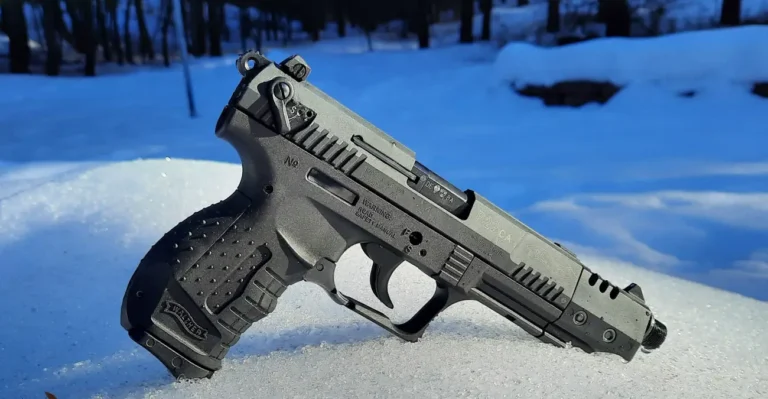As any shooter can tell you, the price of ammunition has skyrocketed over the past several years. While we seem to be slowly coming out of yet another ammunition shortage, a day at the range is not as affordable as it once was. Even for handloaders, the cost and availability of reloading components doesn’t offer much of a solution. Whether you buy factory loaded ammunition or you are a handloader, you’d be hard pressed to find a cheaper price per round than a .22 caliber. For target practice and general plinking around, the .22 is a very cost-effective way to go.
There probably isn’t a single style of firearm that you can’t find chambered in .22, including pistols, rifles, bolt-actions, semi-automatics, single shots, and whatever else you might be able to think of. As a firearms instructor, I appreciate the value of practicing even the most basic fundamentals of shooting. Stance, breathing, sight picture and trigger pull are all the same regardless of what caliber you are shooting. With the possible exception of long-distance shooting, if you’re not hitting your target with a .22, then you’re not going to hit your target with a larger caliber either.
For this review, I will be writing about one of the most used .22 caliber pistols I own, the Walther P22. The Walther P22 is a semi-automatic, double action pistol chambered in .22 Long Rifle (LR) with a polymer frame. It was originally introduced in 2002 and is manufactured in Germany by Walther, and distributed in the Unites States with the help of Smith & Wesson. The P22 is available in two versions. The “Standard” version has a 3.4-inch barrel, while the “Target” version has a 5-inch barrel. The frames are the same on each version, making the barrels interchangeable. The Target version (with the longer barrel) comes with a slide extension that covers the extra 1.6 inches of the longer barrel. My Walther is a Target version.
Threaded barrel adapters are available (and prevalent) for the P22. The threaded barrel adapter replaces the barrel nut, and allows the addition of a suppressor with a 1/2”- 28 thread pitch.
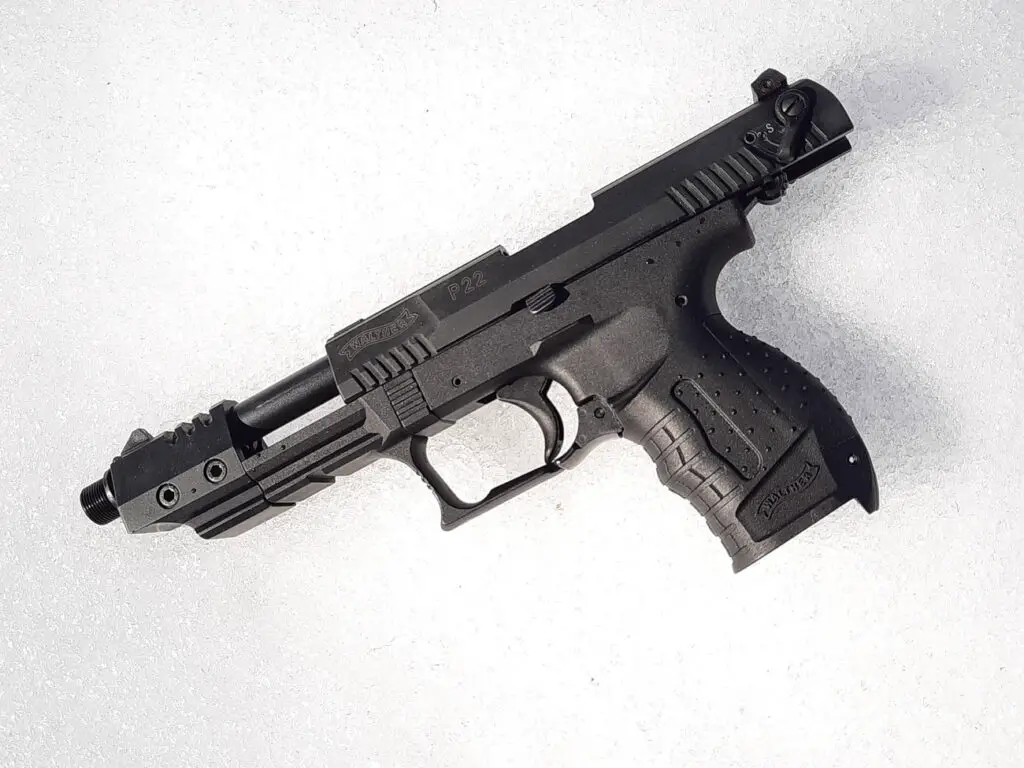
Check Price at:
Specs
- Standard Target
- Magazine Capacity: 10 10
- Barrel Length: 3.4” 5”
- Overall Length: 6.3” 7.8”
- Height: 4.5” 4.5”
- Width: 1.1” 1.1”
- Weight: 16oz (1.0 lbs) (unloaded) 21.5oz (1.34 lbs) (unloaded)
- Action: Semi-Automatic, Double-Action
- Trigger Pull Weight: (Double Action) 12.35 lbs., (Single Action) 4.85 lbs.
Cost
The cost of a Walther P22 can vary a bit. The Standard (short barrel) version can generally be found in about the $300 range. The Target (long barrel) version is normally between $400 and $450. These prices are based on a plain black model. Walther offers several other color schemes, including flat dark earth, angel blue, nickel, and military, which is essentially OD green. The color can affect the price, but not drastically. For any of you Californians, the price of the P22CA is about the same as the non-California compliant counterparts.
What’s in the Box
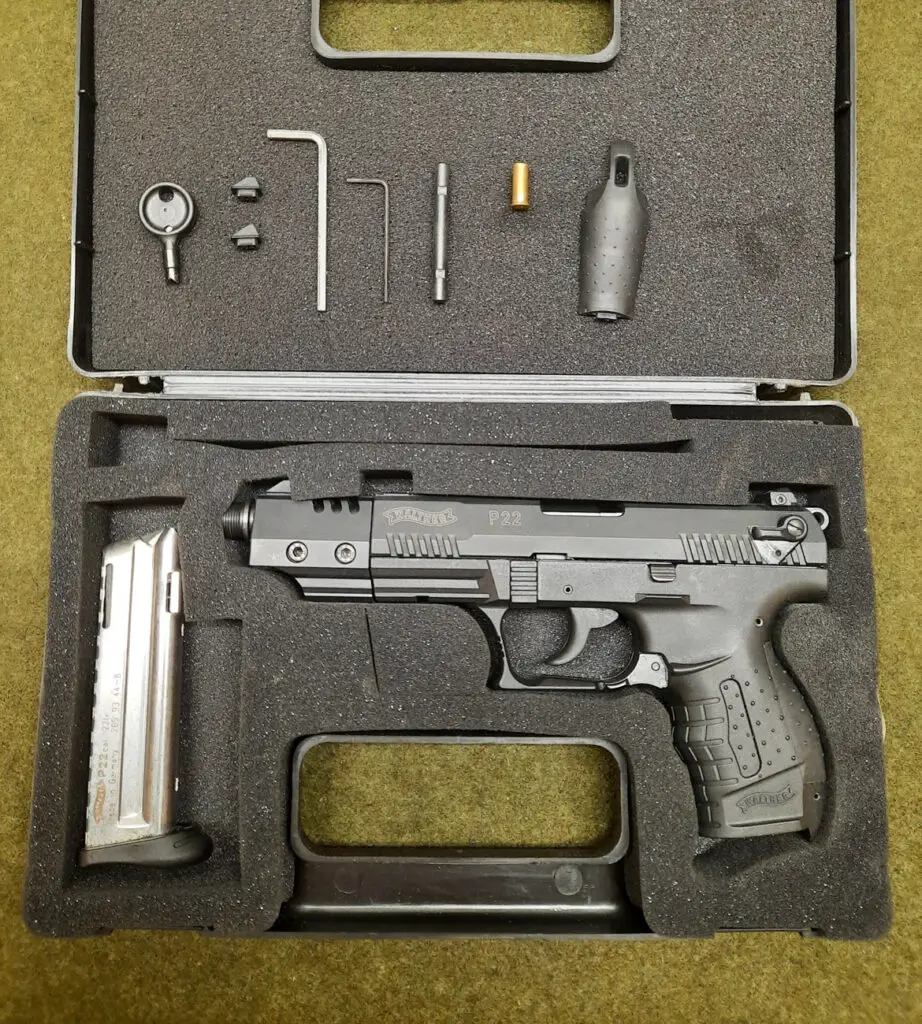
The Walther P22 comes in a hard plastic case with a foam insert. Included with the gun itself was one 10-round magazine, an extra backstrap, two hex wrenches, a trigger lock key (which I’ll discuss later), a plastic mounting pin, and two extra front sights. Because my P22 was originally a P22CA, it did not come with a barrel wrench, but non-California compliant P22’s should come with one. Also in the box is a spent .22 LR shell casing that was fired from the gun during quality control.
First Impression
The Walther P22 is a small framed pistol, but not too small. The polymer grip has a very slight texture to it. The backstrap is very rounded and flares out toward the bottom. The P22 does have a removeable backstrap, and a slightly smaller one comes in the box if you prefer a smaller grip. The front strap has a very subtle finger groove.
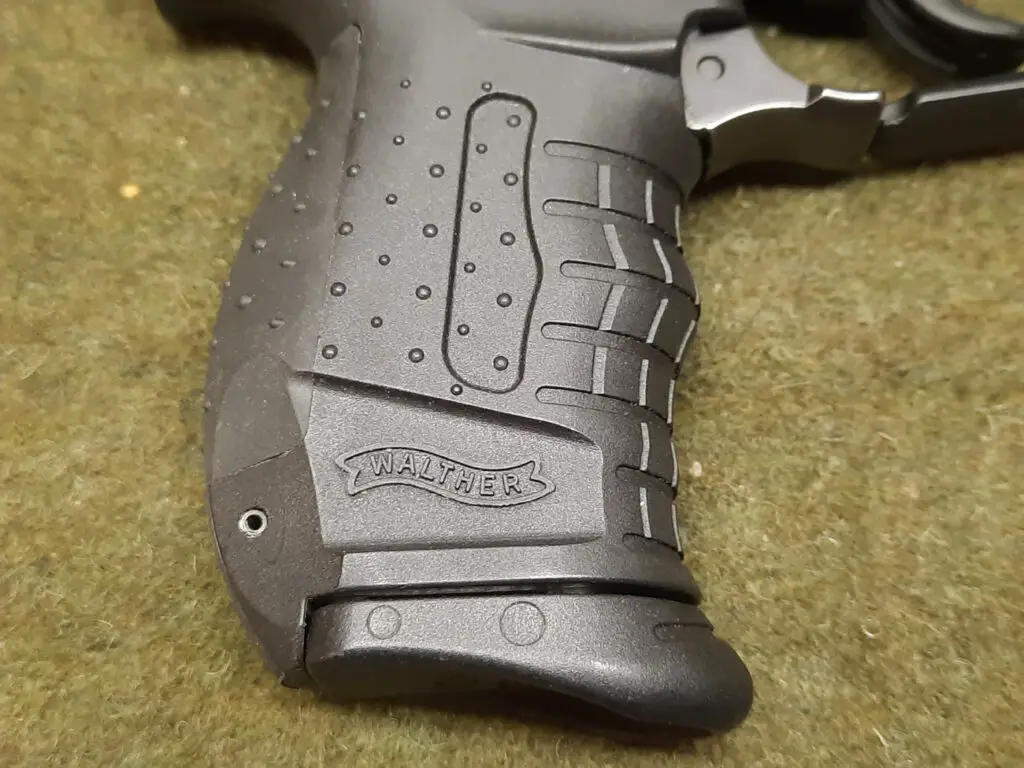
Being such a small framed pistol, the grip is only tall enough to accommodate my ring finger and middle finger, although with the magazine inserted, there is a slight extension the gives my little finger a place to rest. I have fairly large hands, and I usually find small framed pistols to be so small they are hard to control. This is absolutely not the case with the P22. Overall, I found the P22 to fill the palm of my hand very nicely. There is more than sufficient surface contact with my hand, which gives me the feel of total control over the firearm. As cliché as it may sound, holding the P22 makes me feel as if it is an extension of my own hand.
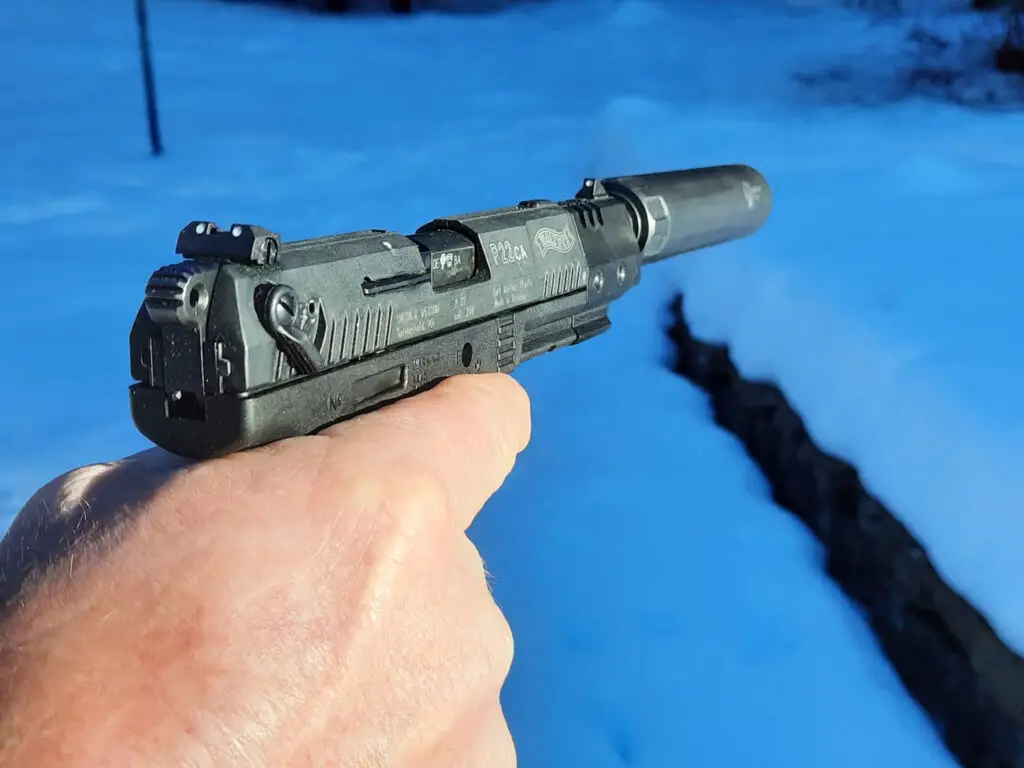
On a personal note, the first experience I ever had with a Walther P22 was when I was working in law enforcement. The narcotics team I was assigned to had seized several firearms during a drug related arrest. One of them was a Walther P22CA. I was tasked with booking the evidence (including the guns) into the property room. As I was handling the evidence, the P22CA caught my attention. I was instantly impressed as soon as I picked it up. Just holding the P22 made me want to go shoot it. Two days later I went out and bought my own.
Sights
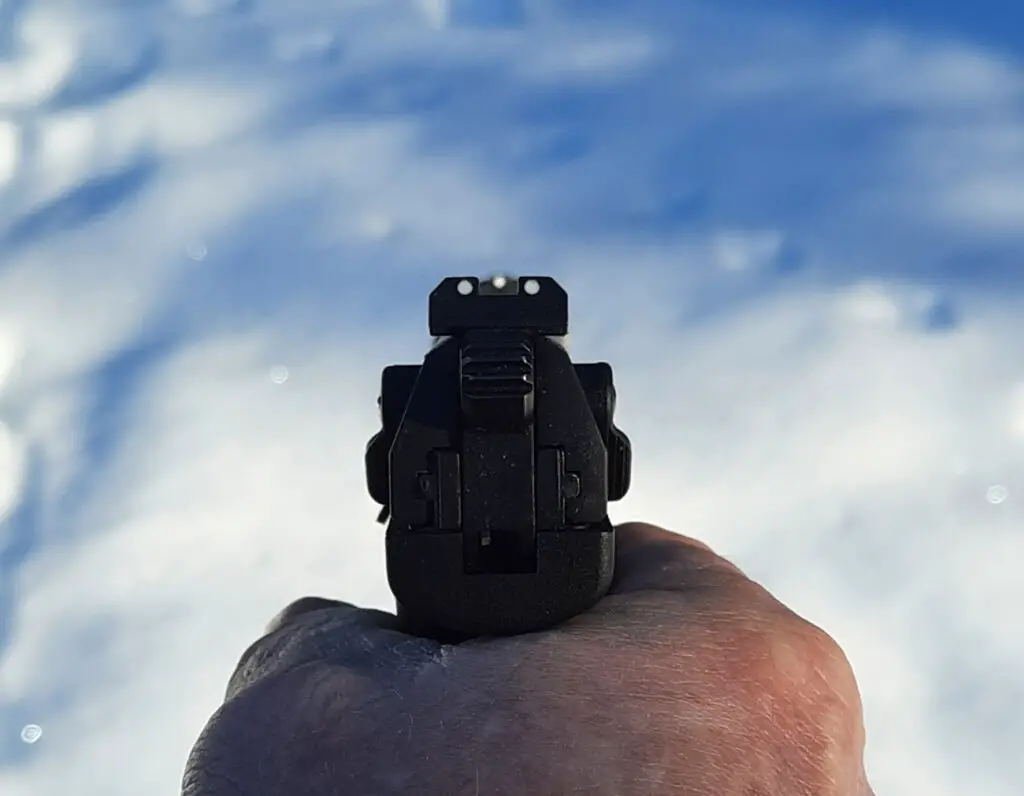
The three dot sights on the Walther P22 are pretty run of the mill. On the Target version, the front sight is attached to the slide extension that covers the extra 1.6 inches of the longer barrel. The rear sights are easily removable. I was somewhat unimpressed with the sturdiness of the rear sights and how they attach to the slide. A little bit of pressure on either side will cause the sights to move. Thankfully I haven’t had any rear sight problems. I suppose they don’t need to be very robust to withstand the recoil of a rimfire .22 LR.
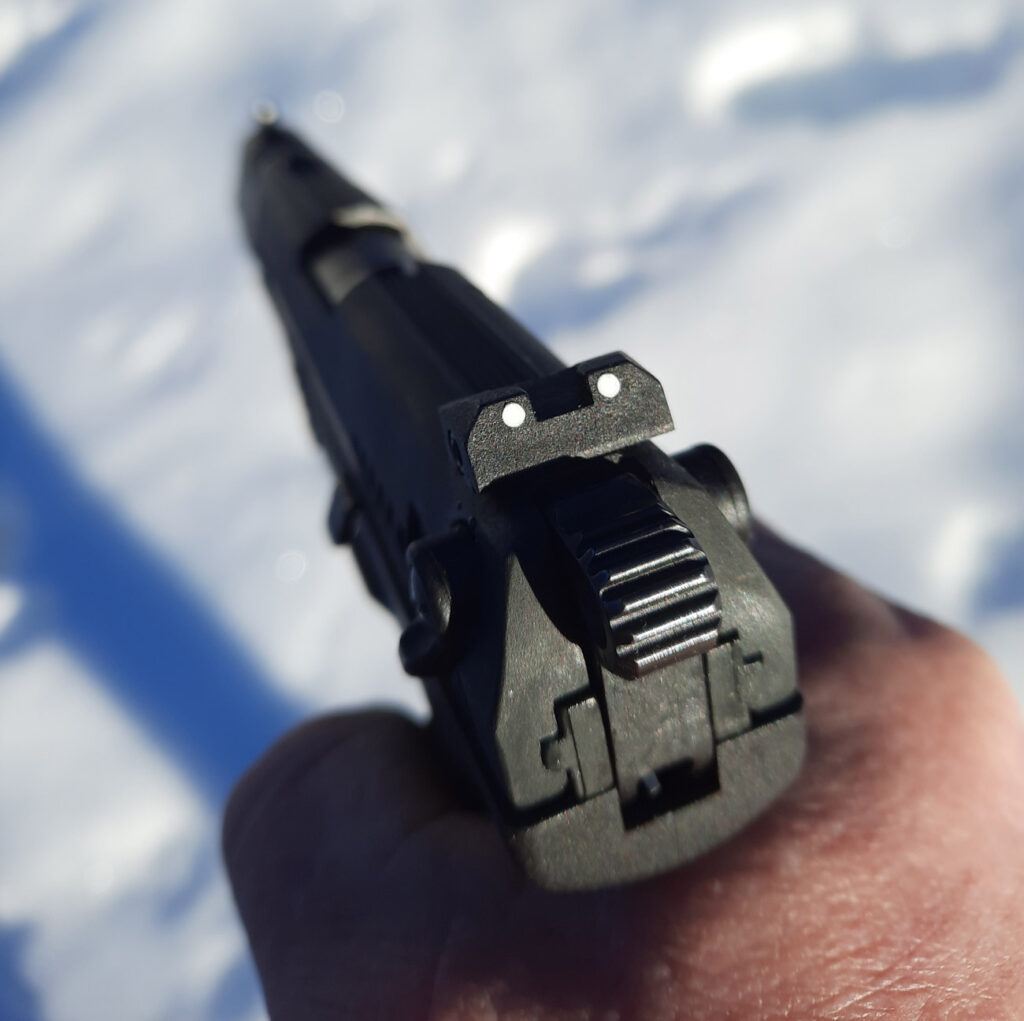
The rear sights are adjustable for windage. The front sight is not adjustable, but the 2 additional front sights that came in the box with the gun are different heights, so elevation can be changed by switching out the front sights. The front sights simply snap in and out of place.
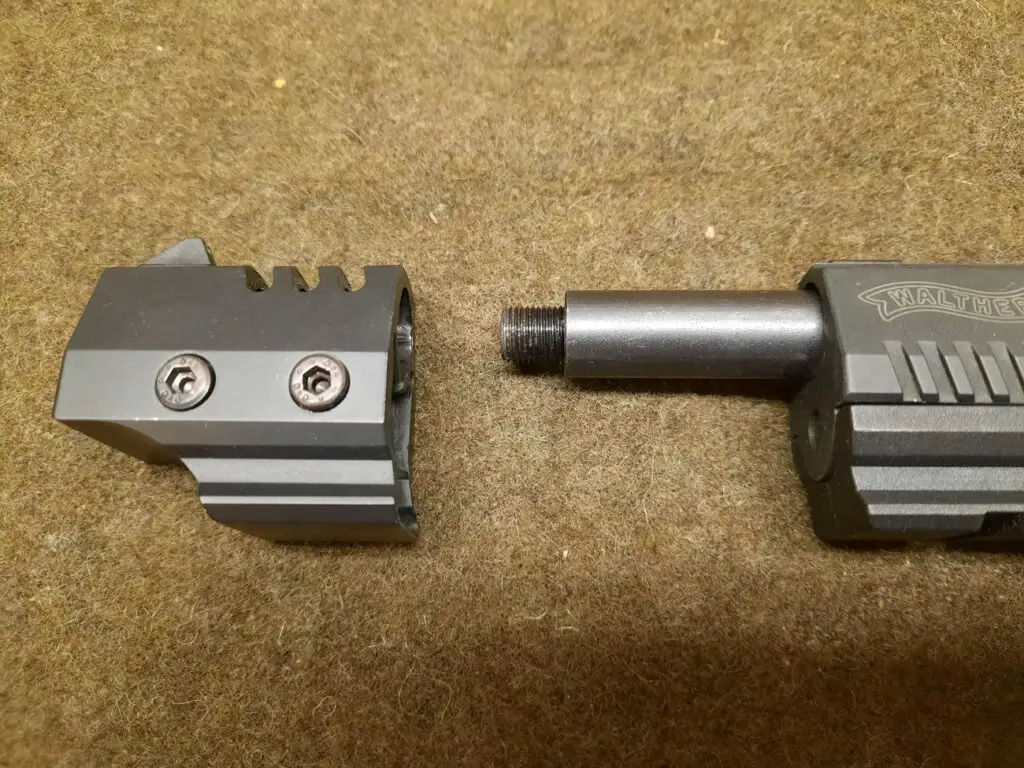
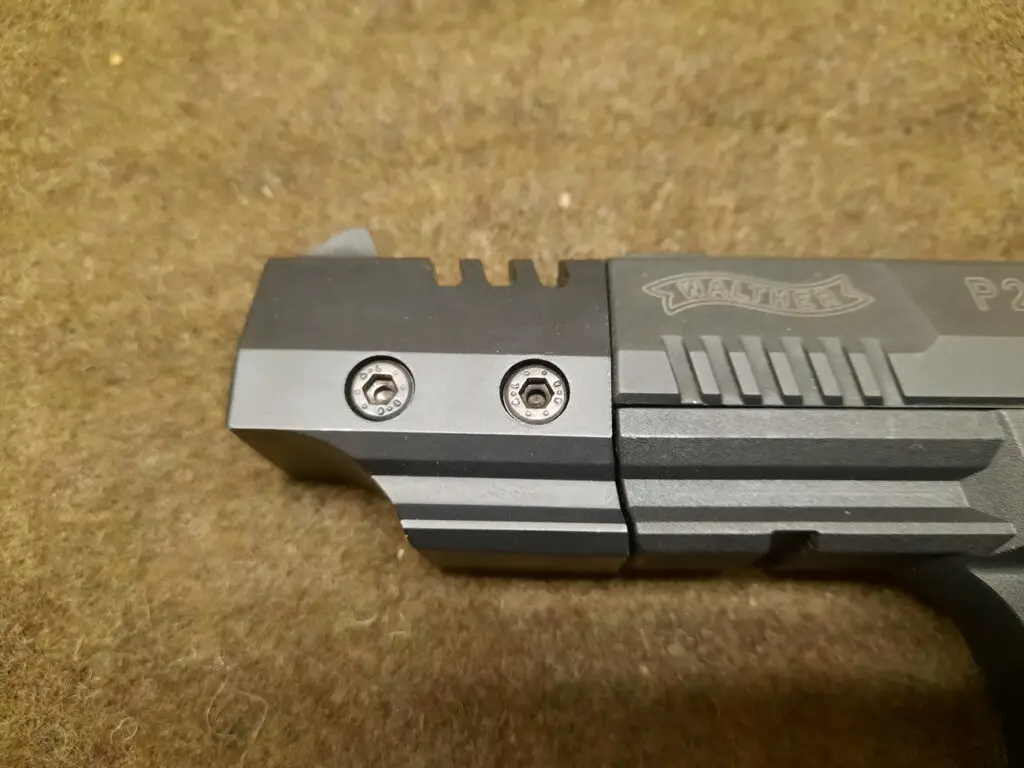
Controls
The Walther P22 safety is thumb operated and is located at the back end of the slide. It is ambidextrous. The levers on either side of the slide are identically sized. With the safety in the up position the gun is ready to fire. In the down position the safety is engaged. An “F” (fire) is visible behind the safety lever on both sides indicating the pistol is ready to fire.
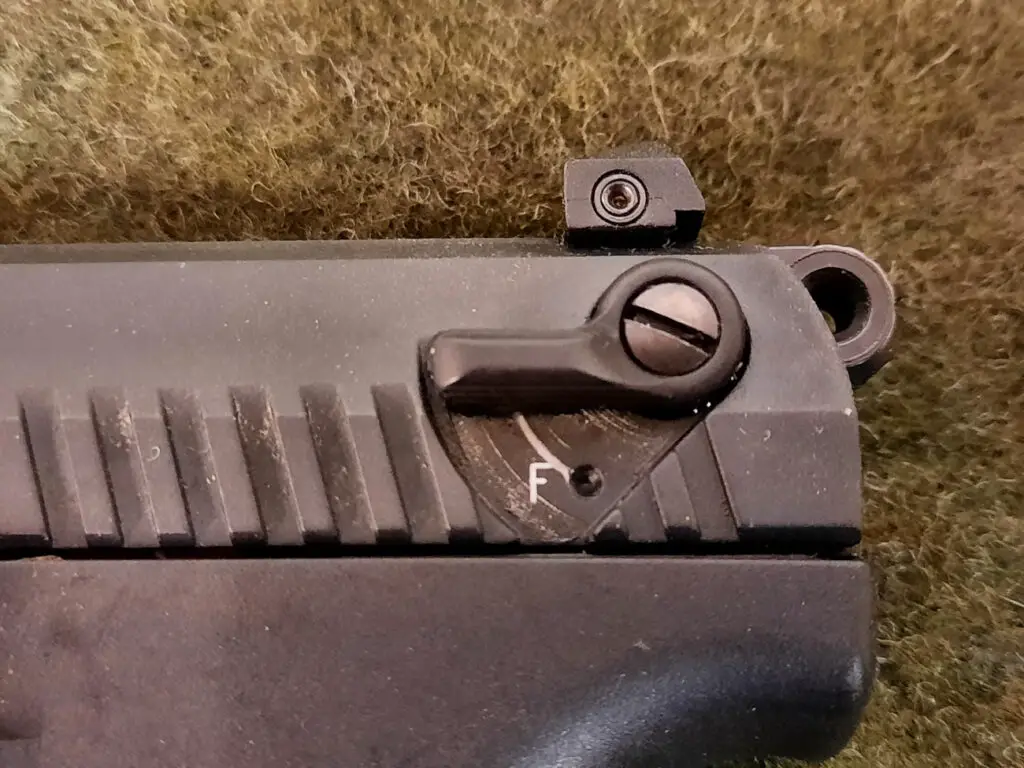
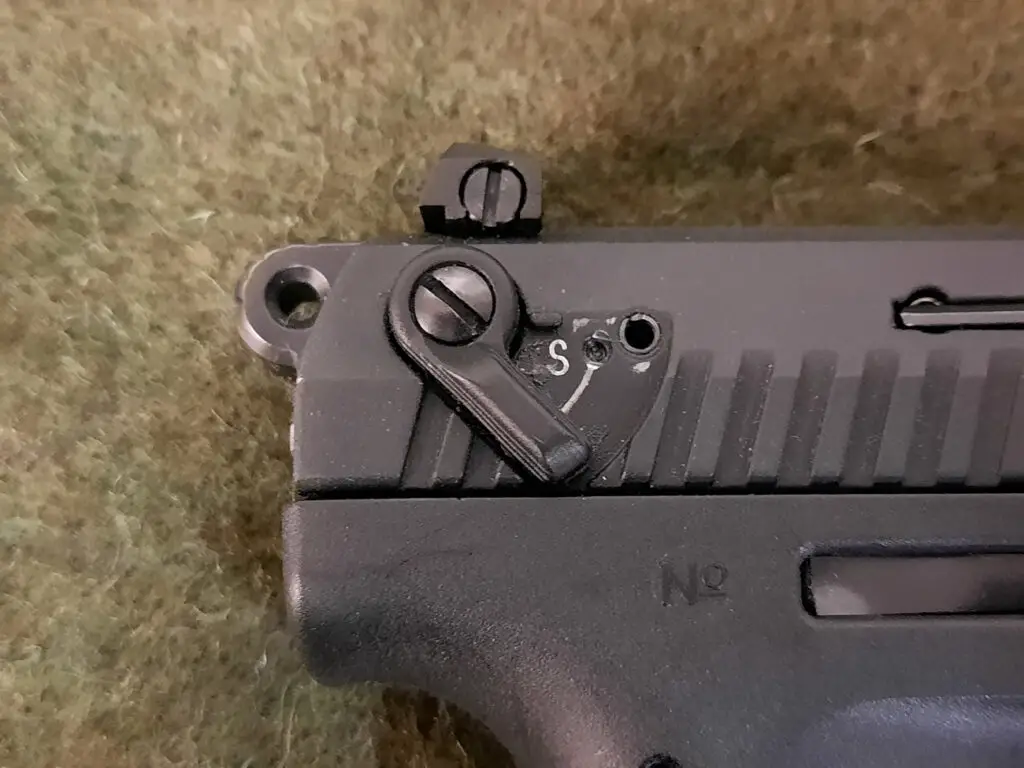
Similarly, an “S” is visible when the safety is engaged. When the safety is engaged, there is a piece of metal that rocks into place just below where the external hammer meets with the back side of the firing pin. This piece of metal prevents the hammer from falling far enough to touch the firing pin. The safety can be engaged whether the hammer is in the cocked position or not.
I found the safety lever to be just a bit too far back. I have to adjust my grip to be able to engage/disengage the safety. I will admit the adjustment I have to make to my grip is pretty slight, but it does affect my sight picture if I’m holding on target when I operate the lever. The levers protrude out from the slide about 3/16 of an inch, which is enough to operate them comfortably.
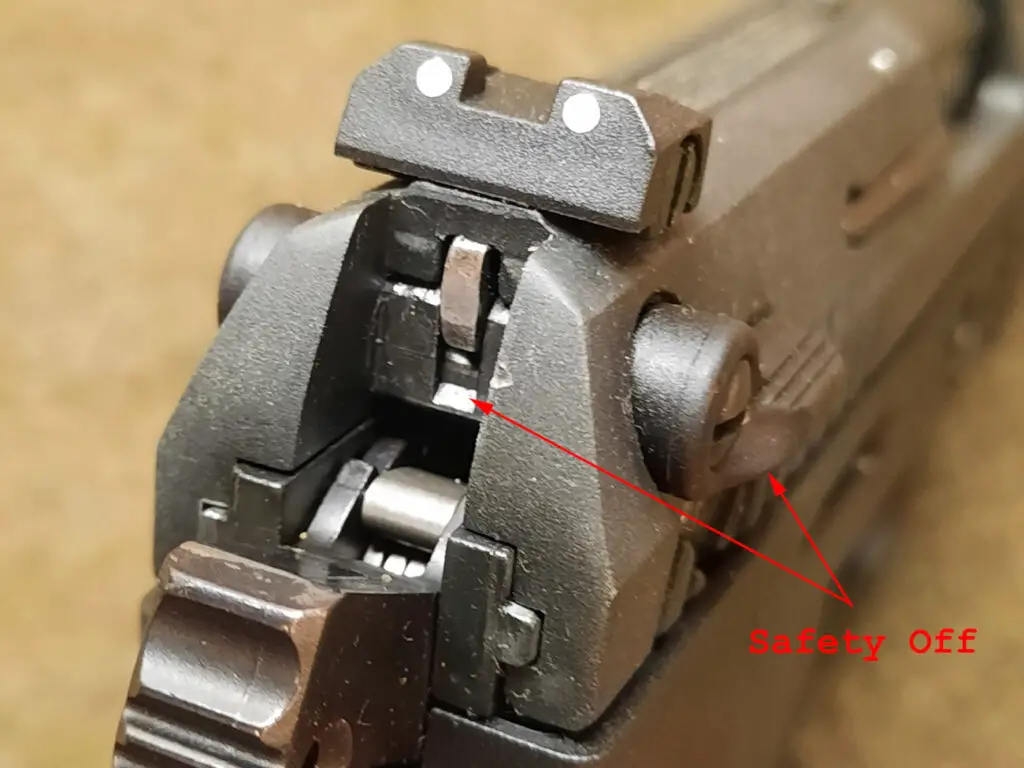
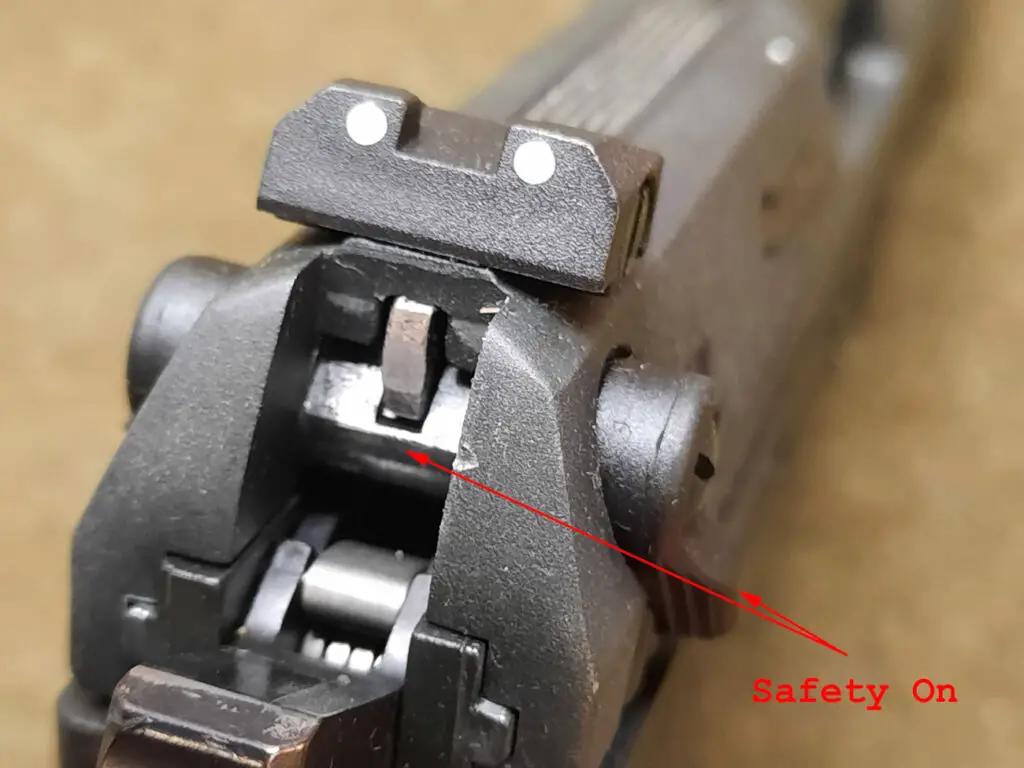
Like the safety, the P22’s magazine release is also ambidextrous. It is not the typical magazine release you would expect to see on a pistol manufactured in the United States. The release is located where the trigger guard meets the grip. The magazine is removed by pushing the release downward using the small tabs on either side of the trigger guard. It takes some getting used to.
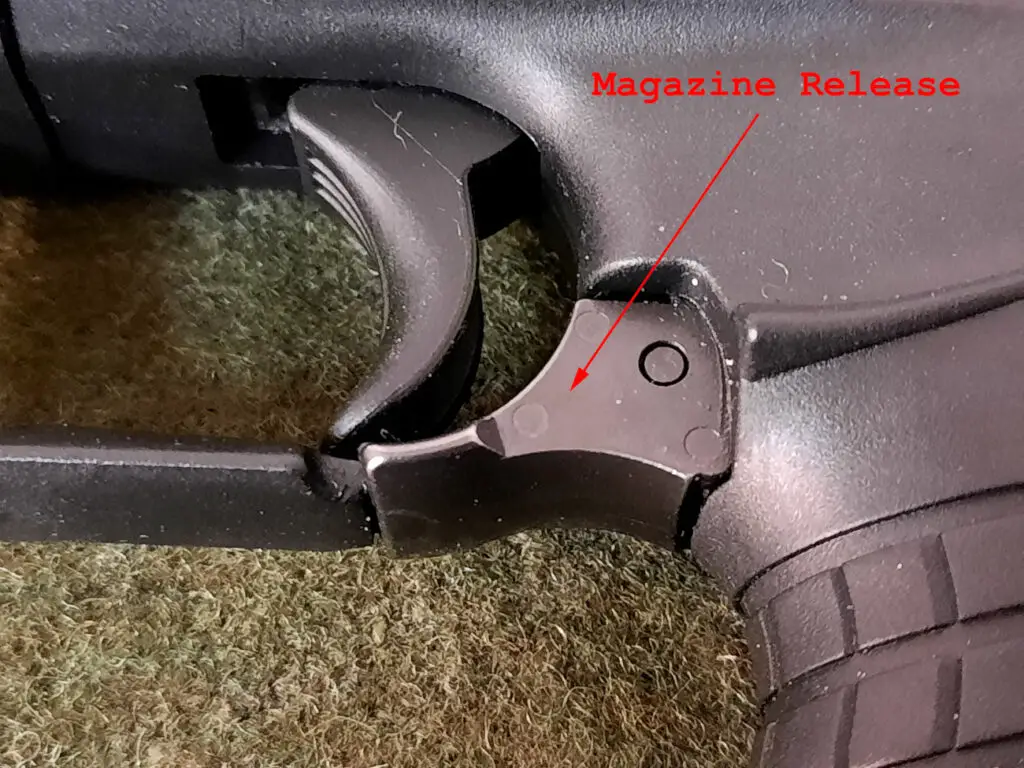
I have never had much luck removing the magazine using only my thumb. It can be done, but I found it much easier to push down on both sides of the release using my thumb on the left and my middle finger on the right. I would rather the P22 had a more traditional magazine release, but I have to say I like it better than the traditional European magazine releases that are typically found at the bottom of the grip and have to be operated with the use of your support hand.
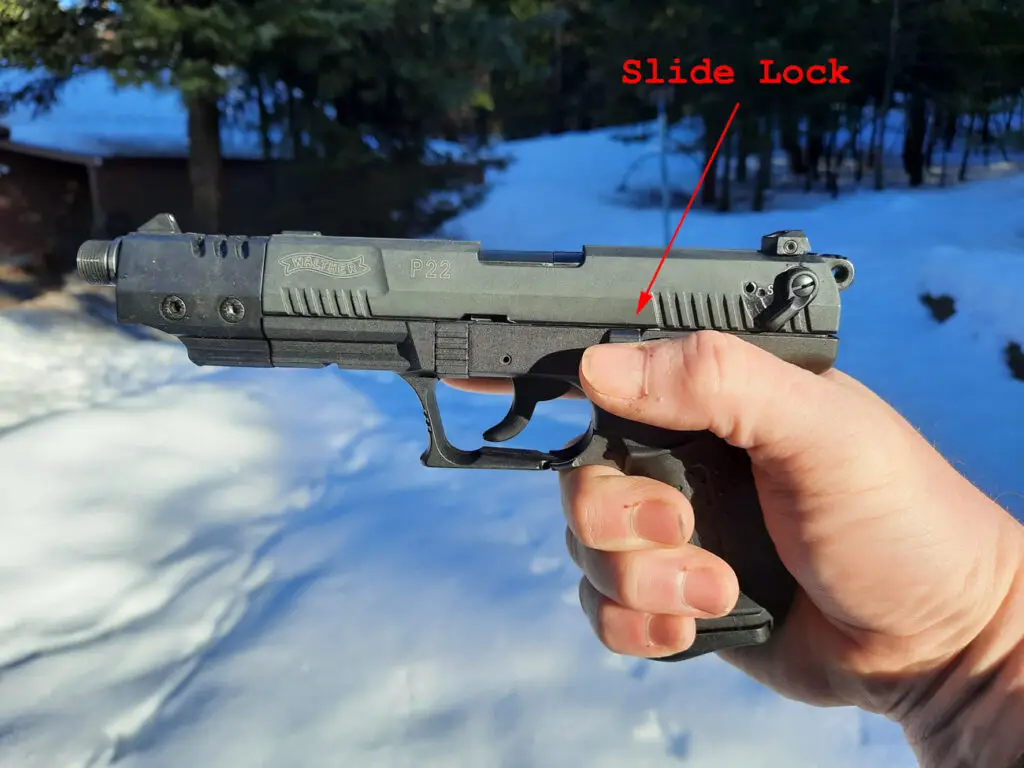
The slide lock is not ambidextrous, and is situated on the left side of the gun for use with the operator’s right thumb. In my opinion, it is perfectly positioned just above where the thumb naturally rests when shooting. There is enough “meat” on it to easily be able to push it up to lock the slide back, or push it down to release the slide forward. Similar to my opinion of the grip, the slide lock is one of the features that outshines most other firearms I have handled.
Trigger
The double-action on the Walther P22 (and any other gun for that matter) means that pulling the trigger completes two actions. With the hammer in the forward position, pulling the trigger will first cock the hammer, and then release it to fire. The travel of the trigger when firing in double-action is just slightly over .6”. With the hammer cocked (firing in single-action), the trigger travels just under .2”.
The trigger is fairly wide for such a small framed gun, which I liked. There are a few vertical groves on the front of the trigger. The grooves are subtle enough that the pad of my finger doesn’t really feel them, but they do provide enough traction to keep my finger from sliding. The trigger pull is smooth enough for a semi-automatic double action, despite the 12 lbs of pull that’s required. In single-action, I didn’t really notice any significant “creep” before the trigger released the hammer. I though the nearly 5 lbs of pull in single-action felt a little on the heavy side. When shooting in both single-action and double-action, the trigger definitely needs to be deliberately pulled, but that’s not such a bad thing for a .22 LR plinking pistol.
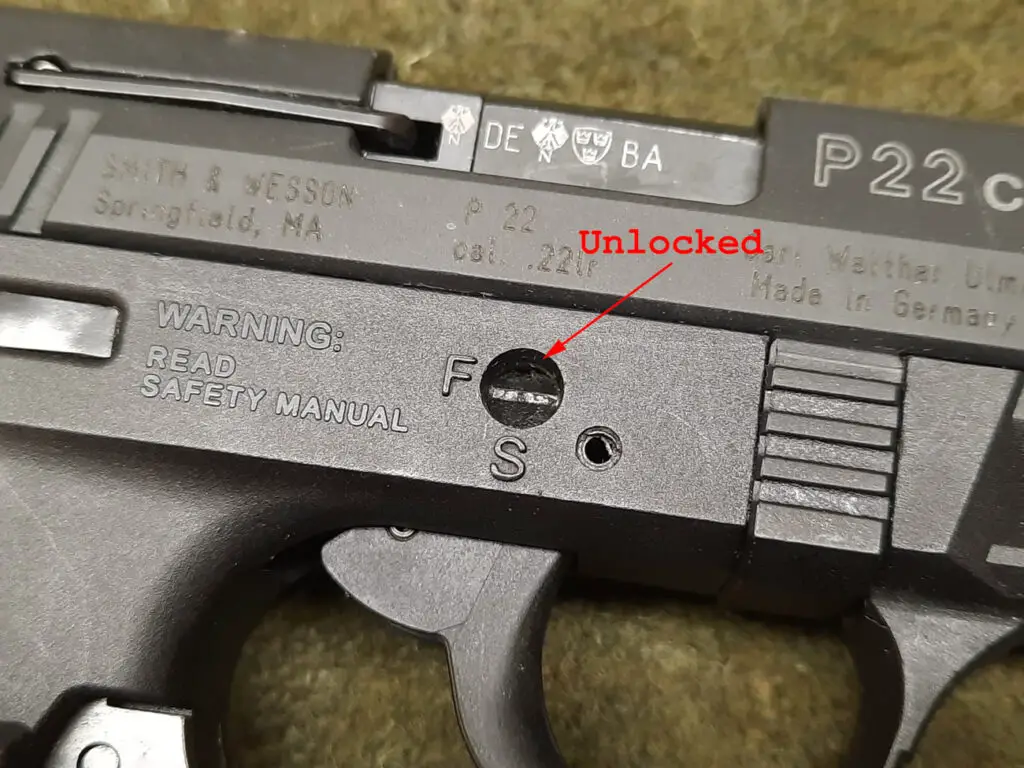
One feature of the P22 that isn’t on any other gun I own is the existence of a trigger lock. On the right side of the frame, just above the trigger, there is a round hole marked with an “F” and an “S”. The trigger lock key that came in the box fits into the hole and operates a locking mechanism.
When unlocked (in the “F” position), the gun fires normally. When it is locked (in the “S” position), the trigger can only partially cock the hammer. It will not allow the trigger to be pulled all the way back, and therefore the hammer cannot be fully cocked or released. The trigger lock isn’t a feature I’ve ever used, but it is there for anyone looking for that extra layer of safety.
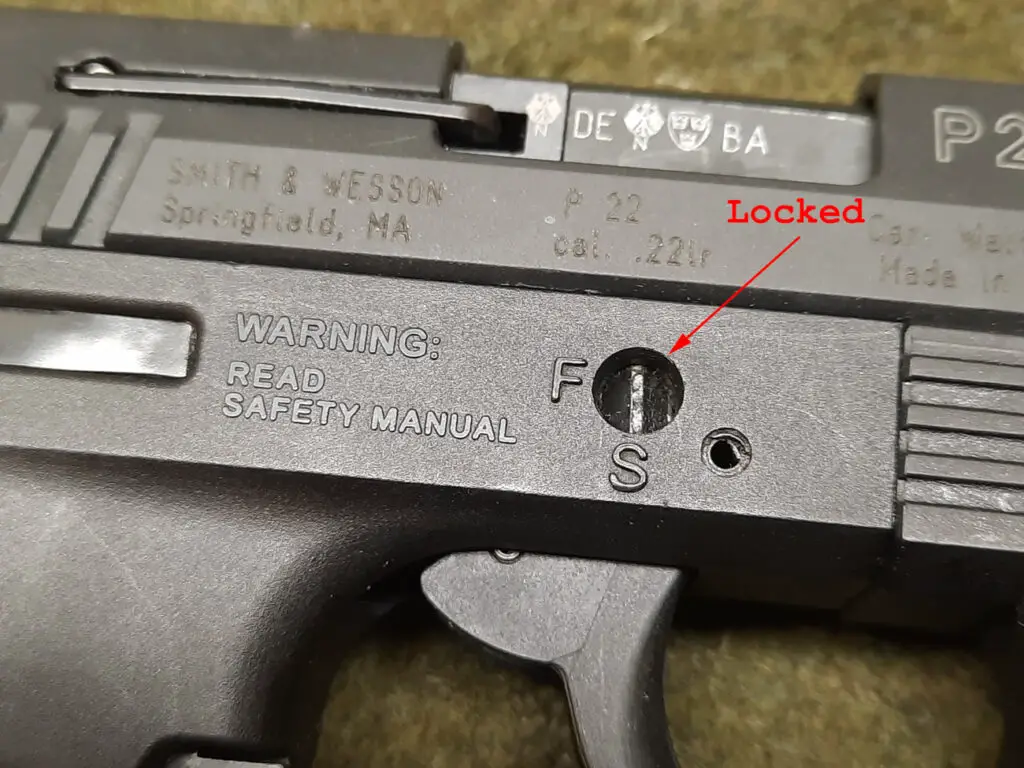
The key is pretty rudimentary, and is really just a tool that allows you to reach into the hole on the frame and turn a knob. If a person were to lose the key, I’m sure the trigger lock could be engaged/disengaged with the use of tweezers or small needle-nosed pliers.
Shooting
As I mentioned before, when I first held the Walther P22, it made me want to shoot it. When I finally got the chance to take it out to the range, I was not disappointed. Shooting it only made me want to shoot it more.
For me, shooting .22 caliber pistols is a kick in the pants anyway. Unlike larger calibers, recoil and muzzle rise are not really a factor. I do not have the shorter barrel, so I cannot speak to how the Standard P22 shoots. The Target version, however, is very consistent and accurate. The longer barrel and the slide extension on the Target version add some weight to the front end, which probably reduces the muzzle rise even more. It seemed as though I never lost my sight picture, even when rapid firing.
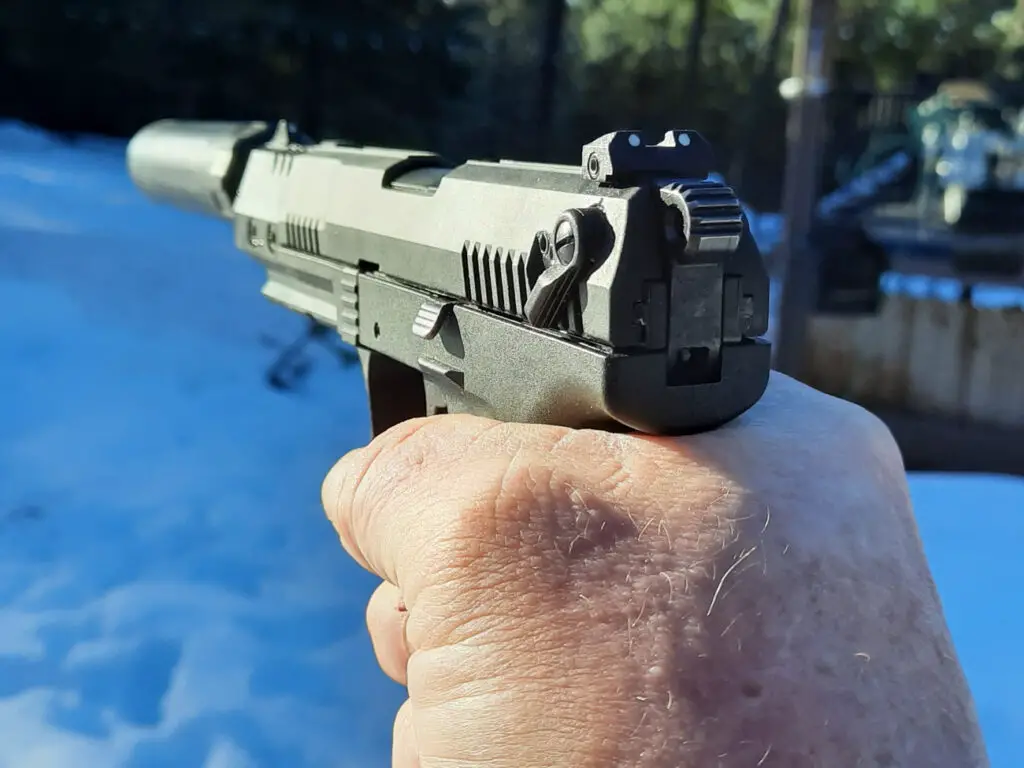
As with any semi-automatic double-action, after the first shot, every subsequent one is fired in single-action, which sometimes (for me) makes the desire to rapid fire overwhelming. I only wish the P22 came with more than one magazine. I would rather do more shooting and less reloading. Getting more magazines are on my do to list, but I haven’t gotten around to it yet.
The P22 has an internal magazine safety that does not allow the gun to fire if there is a round in the chamber but the magazine is out of the gun. When the magazine is out, the trigger is completely disengaged and will not do anything when it is pulled. I’ve never been a fan of this feature, but I am usually looking at it from the perspective of defense and tactics. When I remind myself that a .22 caliber pistol is not something I would consider carrying as a personal defense weapon, it doesn’t bother me so much that the P22 has that feature.
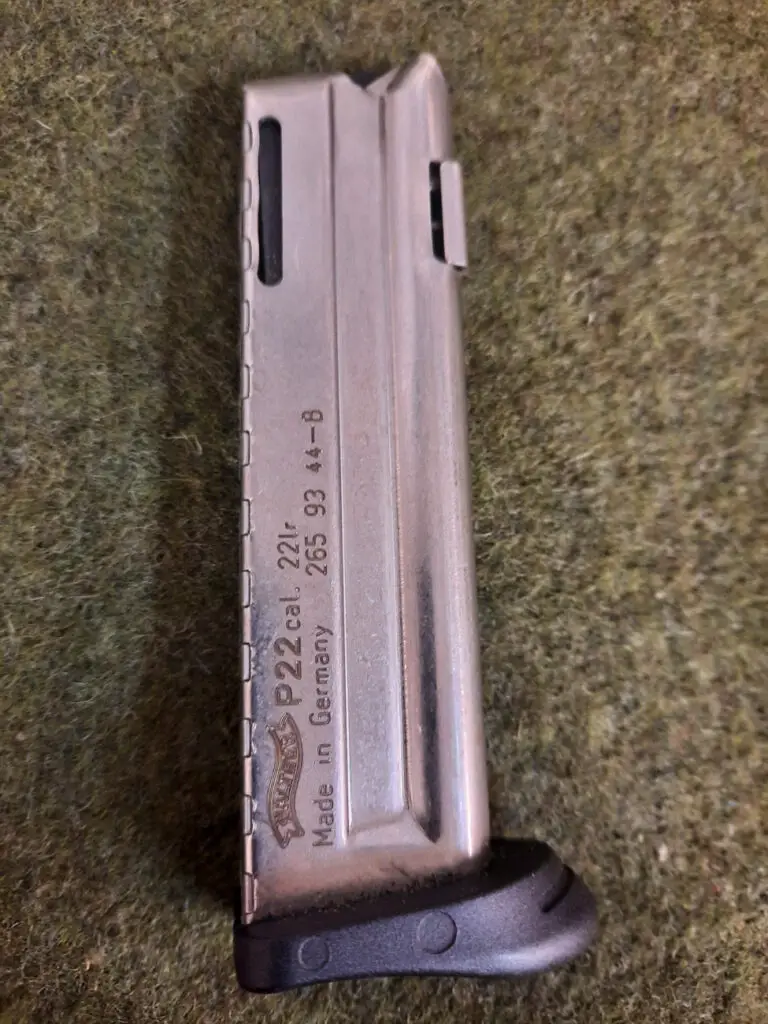
One thing I always have a problem with on my P22 is the slide locking back after the last round is fired. Sometimes it locks back and sometimes it does not. Most of the shooting I have done with the P22 was using an ammo can full of mismatched .22 rounds. Some are high velocity and some are not. I have read that the P22 likes to shoot high velocity rounds in order to cycle properly. I have never had any cycling problems, but the mismatched ammunition may have something to do with my slide failing to lock back consistently. I’ll have to do some more testing to confirm my theory.
Suppression
After owning my Walther P22 for a few years, I moved out of California and into a state where threaded barrels and suppressors are legal. I couldn’t put a suppressor on my P22 fast enough. The suppressor I decided on was the “Mask” manufactured by Deadair Armament. I didn’t have any particular reason for choosing this suppressor, other than it was one of several models that are low profile enough that the sights on the gun can still be seen and used. At about 5 inches in length, the Mask nearly doubles the overall length of the P22 (Target version), but the additional weight is negligible. The cost of a Deadair Mask is in the $400 range.
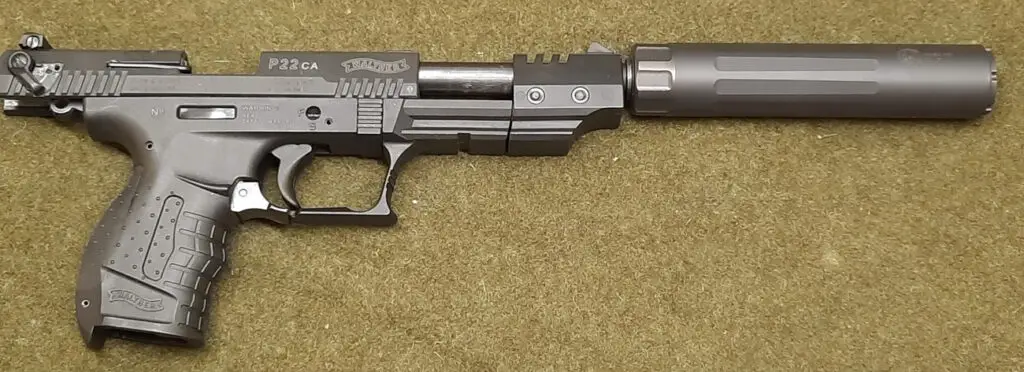
As far as I’m concerned, shooting a suppressed Walther P22 should be on everyone’s bucket list. With the right ammunition, the P22 fitted with a Deadair Mask is incredibly quiet. I would say the sound of the action cycling is probably most of the sound that is heard. I found the point of impact dropped an inch or two at about 50 feet, but shooting through a chronograph showed the suppressor does not affect the velocity.
When I say “with the right ammunition”, I am not necessarily referring to .22 LR ammo that is designated as subsonic. Most .22 LR ammunition will state on the box what the expected velocity is. “High Velocity” rounds are usually anywhere between 1200 and 1400 fps. A projectile will break the sound barrier at about 1125 fps. Whether or not ammunition is advertised as subsonic or not, anything below the 1125 mark is. With high velocity ammunition, the suppressed P22 is still quiet, but there is a “crack” in the air that can be heard because the bullet is breaking the sound barrier. Shooting a round traveling under 1125 fps eliminates that cracking sound altogether and is significantly noticeable.
Breakdown/Cleaning
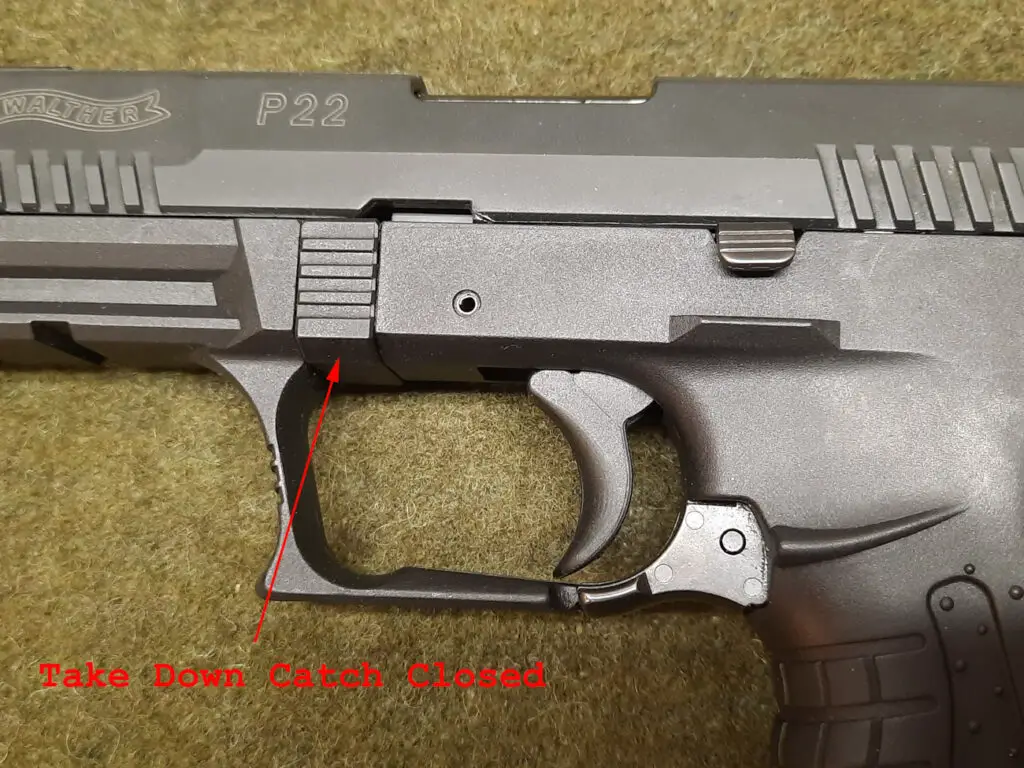
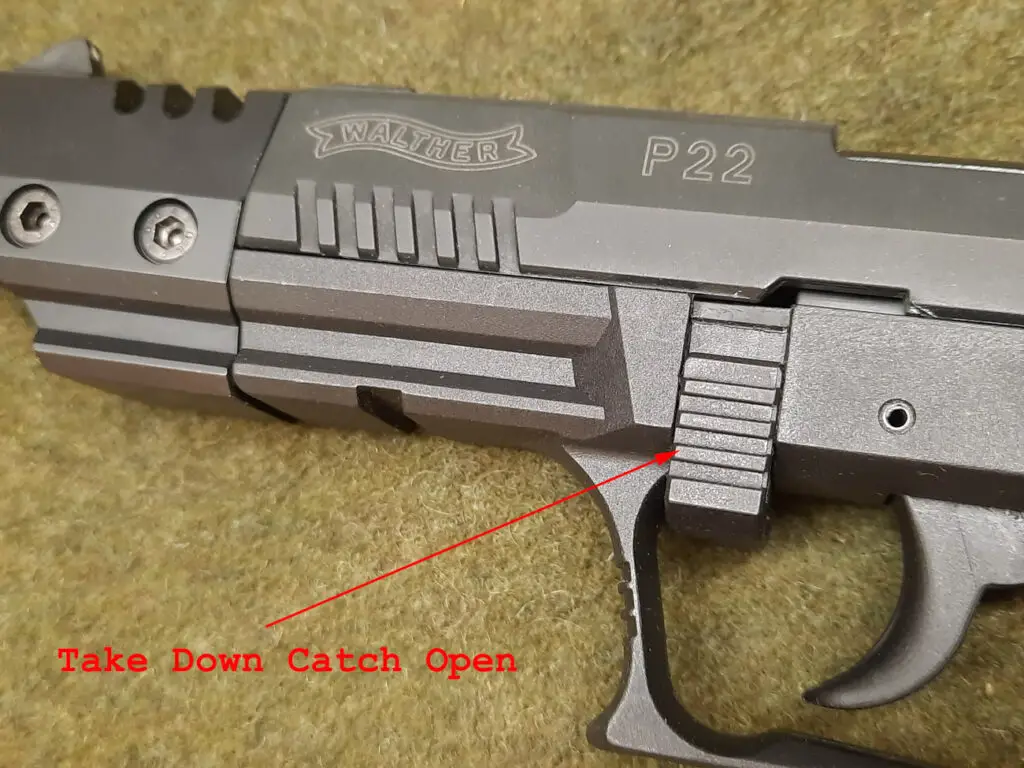
Field stripping the Walther P22 is fairly straight forward. On the Target version, the first step is to use a hex wrench to remove the slide extension. Once the slide extension is removed, the take down catch needs to be pushed down. The catch is found on the frame just above the front portion of the trigger guard. At that point, pull the slide back all the way and lift up on the rear of the slide. The slide will then separate from the frame and can then be eased forward until it clears the barrel, which is still attached to the frame. The gun can be taken apart further, but there is really no need to do so for cleaning purposes.
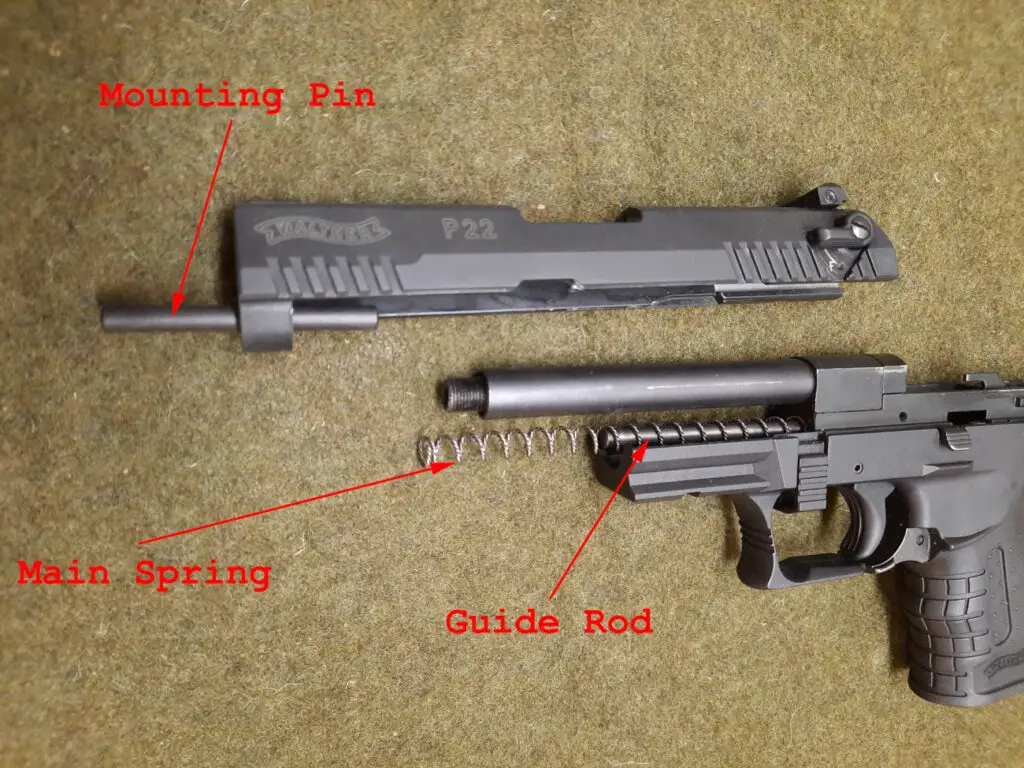
Reassembly is, for the most part, the same procedure in reverse. One of the steps can be tedious and tricky though. The guide rod that runs through the center of the main spring is only about half the length of the spring. According to the instruction manual, the mounting pin that came in the box should be used to install the spring when reassembling the gun. The pin needs to be pushed through the hole in the slide just underneath the barrel. This basically holds the unsupported portion of the spring in place until it gets compressed enough that the guide rod takes over. Realistically anything of a similar size (such as a screw driver) can be used in the same way. I have reassembled mine several times without the use of anything, but I wouldn’t recommend doing that. Without some support, there is a strong risk of bending or kinking the spring if/when it pops out of place. I’d have to say that this design feature (or flaw as I think of it) is what I dislike the most about my P22.
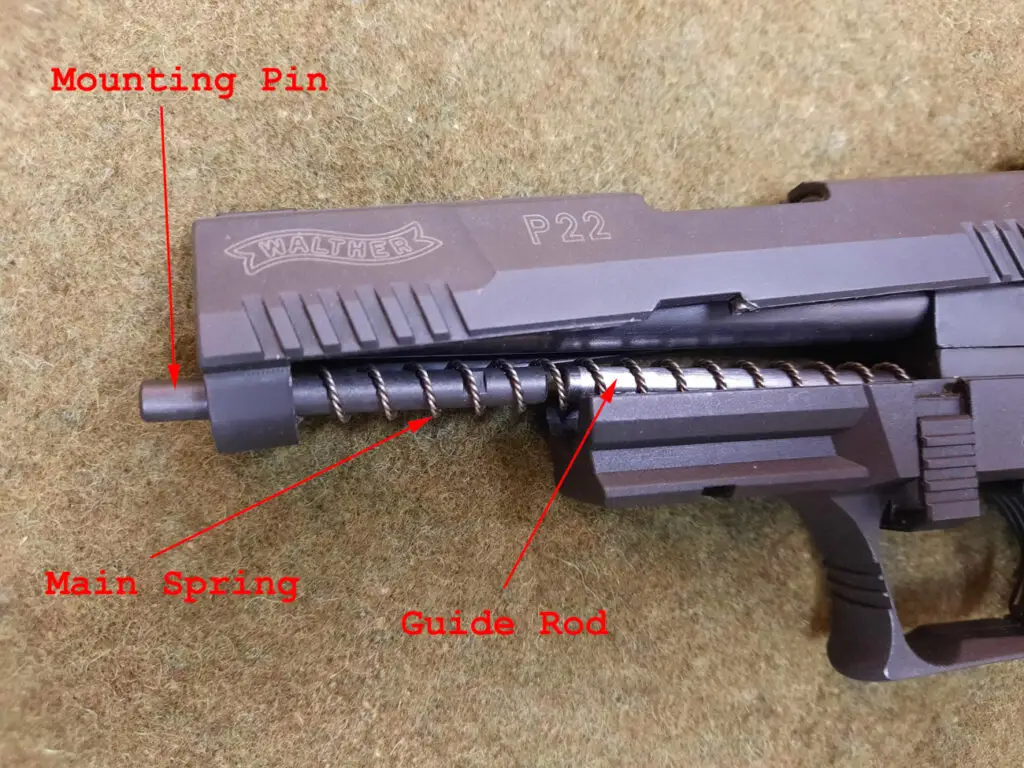
P22 vs. P22CA

As you may notice in the photographs, my Walther is actually a modified P22CA. I suppose I should discuss the difference between the P22 and the P22CA and how I modified it. Whether or not the P22 has a threaded barrel adapter or not, it comes with a removeable barrel nut. The barrel nut has two flat sides, allowing the use of a wrench to loosen/tighten it. Most P22’s come with the threaded barrel adapter.
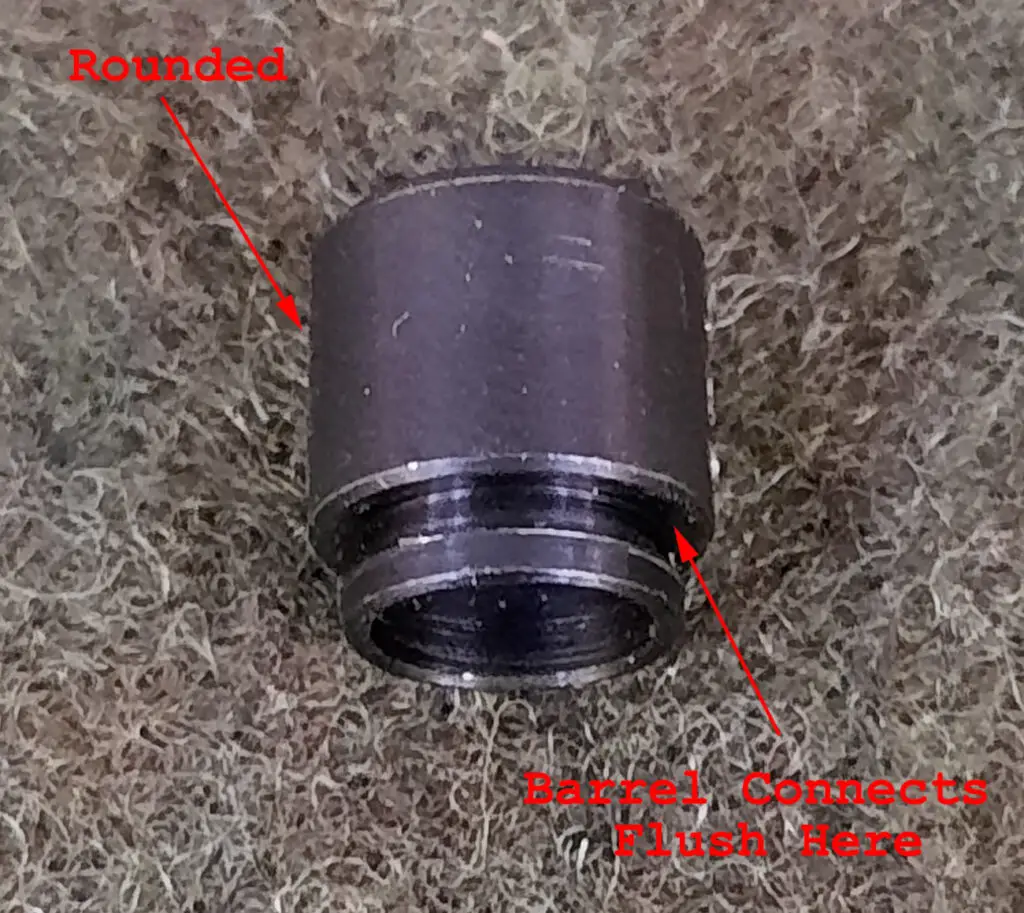
The State of California considers pistols with threaded barrels to be “assault pistols” and are illegal there. Thankfully for the residents of California, Walther released the P22CA, which is a California compliant version of the P22. What is the difference? The barrel nut is not removeable, and thus the threaded barrel adapter cannot be installed (in theory). The barrel nut on the P22CA has no flat spots to accept a wrench, and the threads that hold the barrel nut in place are sealed with an epoxy. Needless to say, I bought the P22CA because I was living in California when I purchased it.
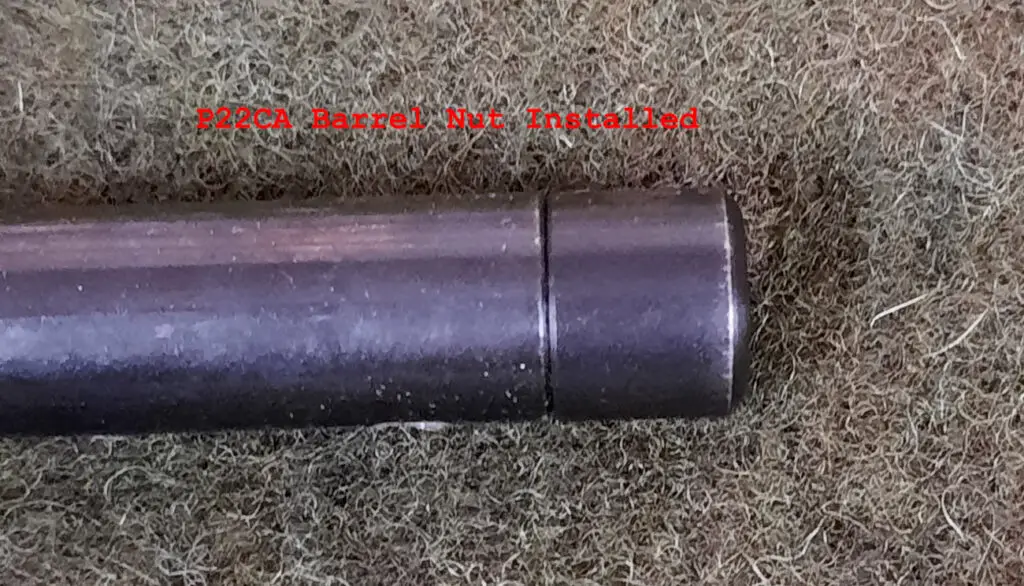
Almost immediately after leaving California, I wanted to celebrate my new found freedom with the addition of a suppressor (which I will discuss more in depth later). After a bit of research, I was able to remove the P22CA barrel nut by applying some heat to the area of the threads to loosen up the epoxy. I then used channel locks in place of a barrel wrench to unscrew the nut. The channel locks caused some scarring on the barrel nut, but I intended to replace it anyway. Once the California compliant barrel nut was off, I simply replaced it with a threaded barrel adapter. I just felt as if I should explain how I came to have a suppressed P22 that is stamped as a P22CA.
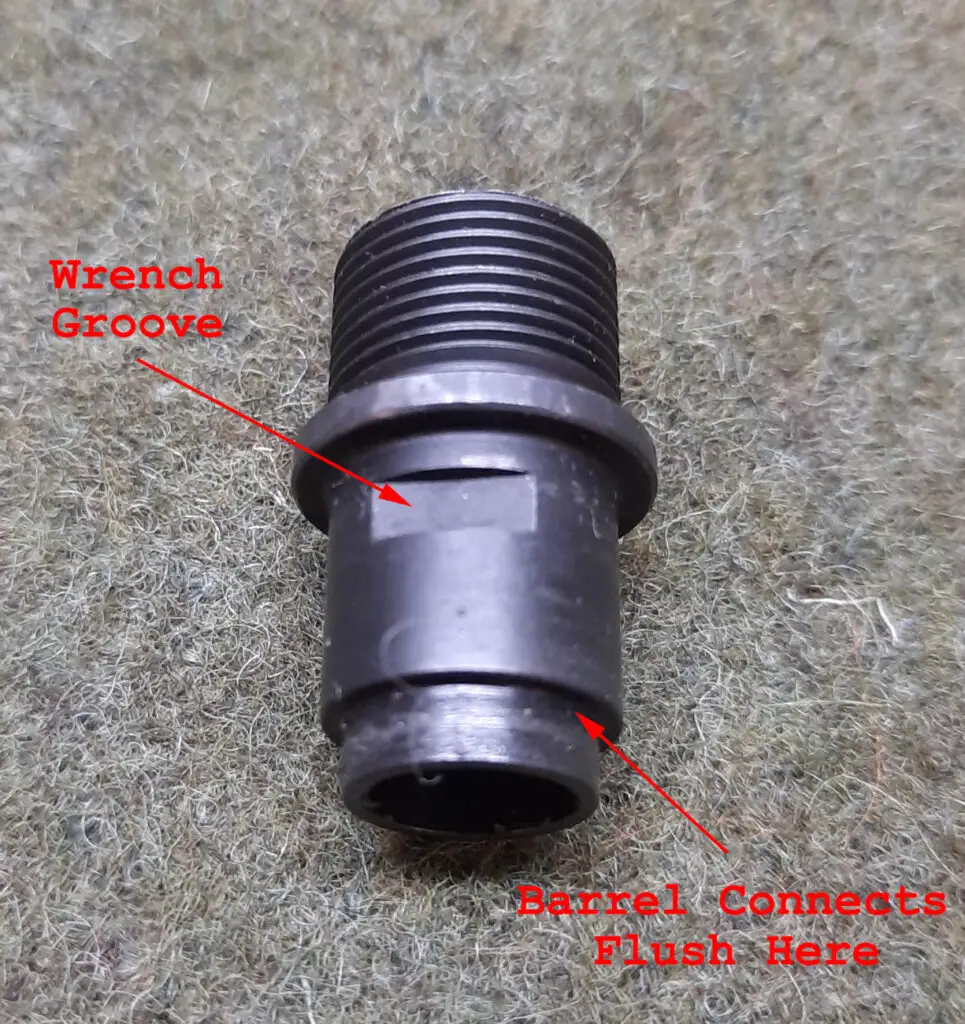
Conclusion
Overall, the Walther P22 is a sleek, nicely sized, and very comfortable pistol to hold and shoot. I would never consider or recommend it as a concealed carry weapon, primarily because the caliber is not an effective one for self-defense. The secondary reason would be the non-traditional magazine release. For a recreational plinking gun, however, I would strongly recommend it. It’s comfortable for just about any hand size, the recoil can be managed by anyone, and it is sufficiently accurate.
The P22 is extremely fun to shoot. I have to add that as much as I liked shooting it before, it is even more fun suppressed. If you have the ability and the means to suppress it, then do it. If not, the P22 is still very well worth owning.
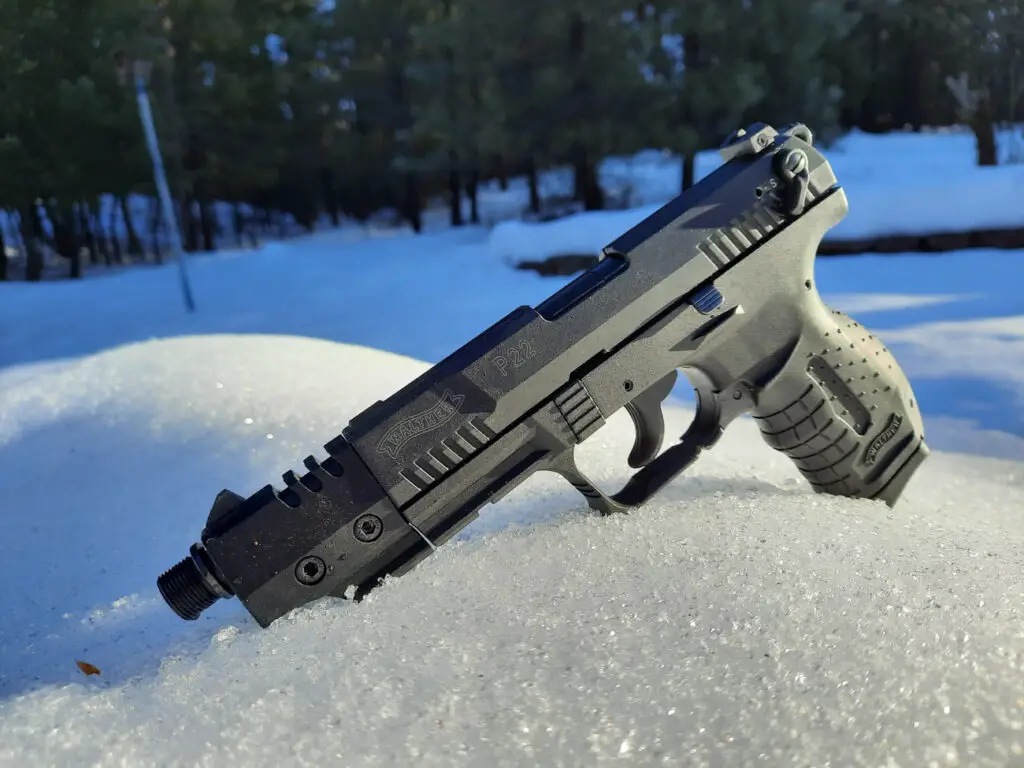
Check Price at:

